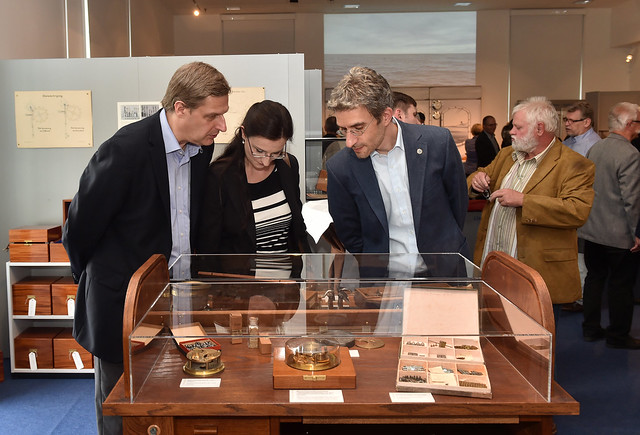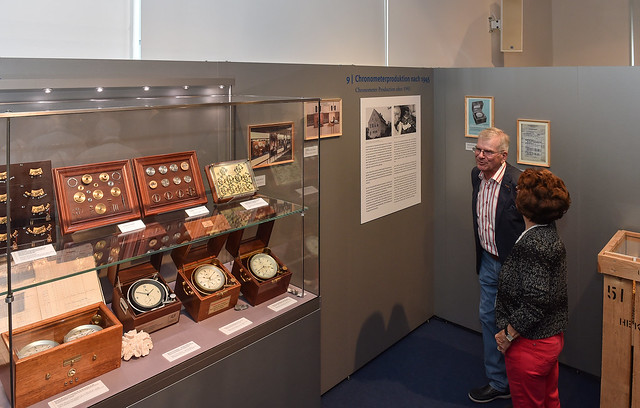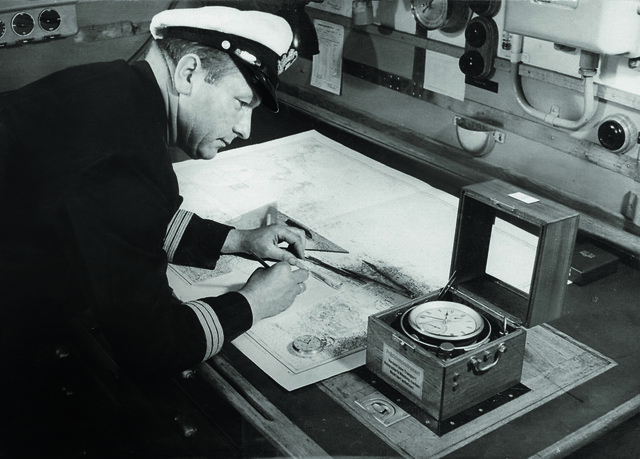16 июня в часовом музее Гласхютте открылась специальная экспозиция, посвященная истории создания морских хронометров. До 20-го ноября она работает, если будет возможность, сходите обязательно.

Цитата:
|
Glashütte on Board – 130 Years of Marine Chronometers from Saxony
New special exhibition at the German Watch Museum Glashütte
On June 17, the German Watch Museum Glashütte opened its latest special exhibition dedicated to the different versions and technical developments in marine chronometers made in Glashütte in the last 130 years, and to the achievements of famous watchmakers and manufacturers of chronometers such as Fridolin and Paul Stübner, Gustav Gerstenberger or Herbert Weydig. The museum presents the development of Glashütte marine chronometers using numerous exhibits, documents and photographs in their historic context. The technical aspects and specific construction details of the chronometer movement are presented to the visitor in an easily understood way in an artisanal context. In addition, a multimedia presentation brings the practical use of marine chronometers at sea closer to the visitor's experience.

Precise timekeeping at sea
For centuries seafarers oriented themselves at sea by observing the stars and using a chip log and logline to measure distance and speed. One of the biggest navigational challenges was to determine the longitude, and only when John Harrison invented the marine chronometer did navigation at sea become significantly more precise and more reliable. With the founding of the German Empire in 1871 and growing interest in international trade, the German Navy became more important as well. To eliminate reliance on English imports, significant support was provided to encourage the production of chronometers in Germany. In 1886 the first marine chronometers from Glashütte were sent to the German Naval Observatory in Hamburg for testing. In the following years numerous innovations and technical improvements brought international renown and success to marine chronometers from Glashütte. These precision timekeepers were manufactured to be used on merchant ships and expeditions. Also after the division of Germany, the production of chronometers in Glashütte continued. The state-owned company VEB Glashütter Uhrenbetriebe took up the tradition and manufactured a large number of mechanical chronometers, and beginning in 1974, quartz-driven chronometers were made as well. They were deployed primarily on GDR ships but also exported worldwide. Although today navigation at sea is performed around the world using GPS, Glashütte in Saxony remains a significant location for the production of marine chronometers. Another aspect of German chronometer history is the connection between Hamburg and Glashütte. Along with the founding of the “German Naval Observatory Hamburg” in 1875 as a testing centre for chronometers, there was support beginning in the 1930s for the joint production of chronometers at both locations and for the establishment of a research institute at the astronomical observatory in Glashütte. Following the reunification of Germany the Hamburg – Glashütte link was taken up again, the Glashütte astronomical observatory was restored and today houses a production of watches and a chronometer testing facility, which also officially certifies the chronometers made by Glashütte Original.

A modern chronometer for the wrist
As a founder of the museum and long-time manufacturer of modern high-end timepieces, Glashütte Original takes advantage of this special exhibition to present the latest version of its successful Senator Chronometer, which was launched earlier this year during BASELWORLD 2016. The new model made of white gold harmoniously unites certified precision and an expressive hue. This elaborate refinement betrays the experienced hand of the craft specialists who make these small-scale works of art in the firm's own dial manufactory in Pforzheim. In careful, delicate detail work the lacquer is applied and dried in several coats until the precise shade and texture desired are achieved.
Ideal historic models
The dial is inspired by the famous marine chronometers of the past and coupled with contemporary elegance. In 2016 the Senator Chronometer appears in a newly designed white gold case with the Senator line's characteristic slim bezel. This ensures not only generous views but makes it easier to read the different displays: the small seconds at 6 o'clock, for example, or the power reserve display at 12 o'clock. The Senator Chronometer also presents the characteristic, colour-matched Panorama Date, along with a separate day-night display that simplifies setting of the date.

Sophisticated technology
The functions are driven by the sophisticated manual winding Calibre 58-01, among its features is a refined stop-second/reset mechanism. The manufactory movement's decorative elements also set a high standard. A sapphire crystal case back permits one to take in at first glance the classic features of the Glashütte art of watchmaking: the famous three-quarter plate, screw-mounted gold chatons and hand-engraved balance cock unite the highest watchmaking expertise with authentic craft skills.

Details on the special exhibition
The exhibition is open to the public from 17 June through 20 November 2016 in the German Watch Museum Glashütte. A companion volume to the exhibition is available for purchase for 6.50 Euro in the museum shop.

|





















 Похожие темы
Похожие темы